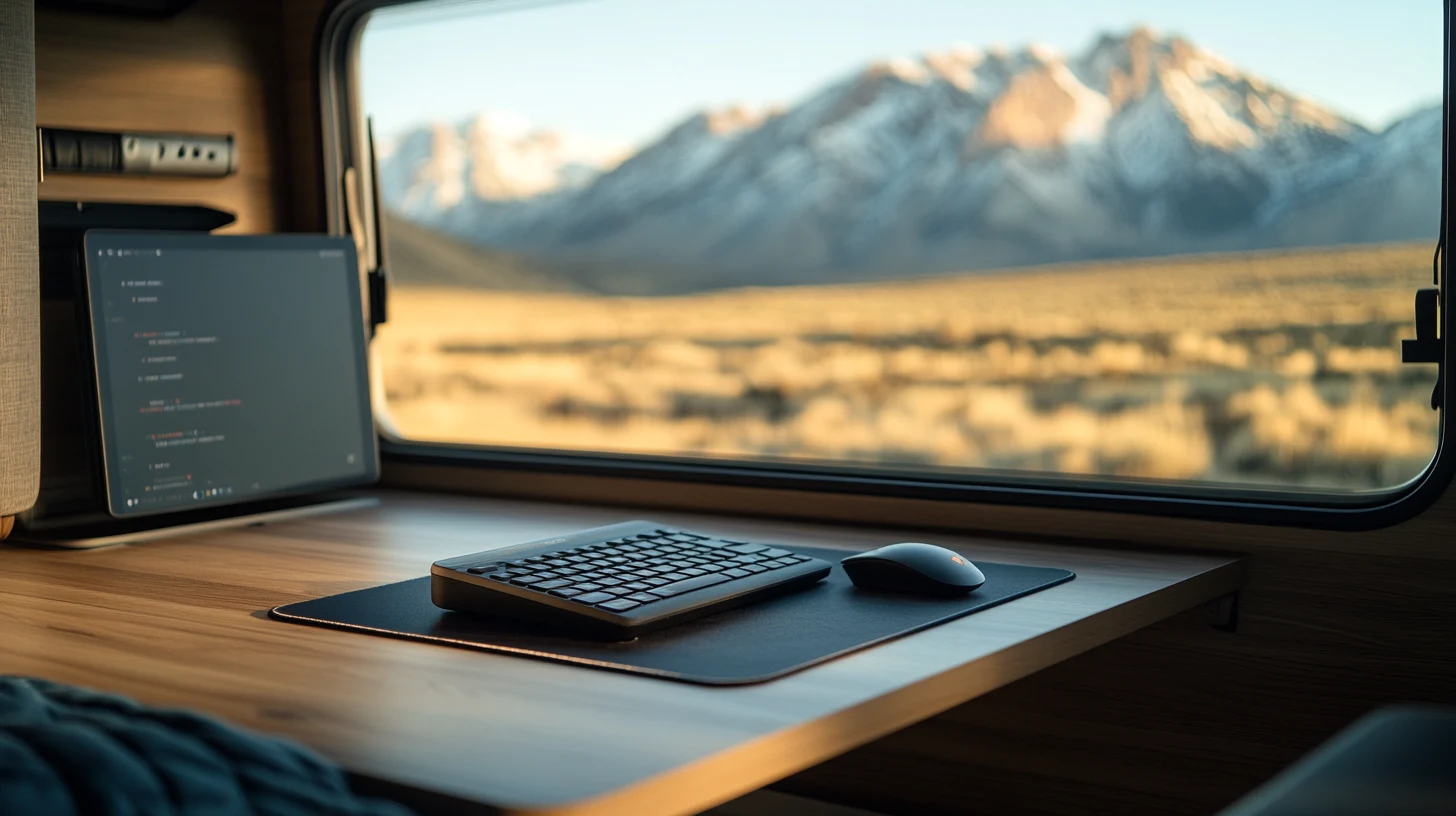
Setting up a mobile office in a van under 20 feet
Living the van life was a dream… but there was no way we were hitting the road without some financial security. (Sure, we wanted to travel, but we needed a safety net.)
But here’s the thing: working from a van isn’t just about plopping down anywhere with a laptop on your lap. You need a real workspace, a setup designed for it (even when you only have 64 sq ft to work with!)
So we put our heads together (and maybe scratched a few walls in the van too 😅) to come up with a work area that doesn’t take over the living space, that’s ergonomic, practical, and most importantly, realistic. We’re sharing all our tested solutions from the road: foldable tables on rails, modular furniture, wall optimization hacks… Nothing theoretical, just real-life experience.
Ready to get some serious work done (even in the great outdoors)? Let’s go 🚐💻
Design Your Ideal Workspace (Solutions for Vans Under 20 ft)
Setting up a proper desk in a van that’s under 64 sq. ft. (6 m²) is a challenge we’ve all faced, but there’s no need to reinvent the wheel. The good news is, your van already has (almost) everything you need to create a comfortable workspace without sacrificing your living area.
The Naturally Included Desk (The Van Table)
You might hear about integrated kitchen countertops for remote work… but let’s be real: who actually works at their sink? Most vanlifers simply use the indoor table, the one where you eat, as their workspace.
And it works great (just set down your laptop, organize your stuff, adjust your position, and voilà, your dining area transforms into a real desk). It’s the most logical, stable spot, and best of all… it’s already there. If you’re both working, each can find their place. One can sit at the main table while the other uses a swivel front seat with a small tray or a support on their lap (this can come in handy if your van only has one swivel seat, though that’s pretty rare these days).
Using the Front Seats (The Nomads’ Favorite Option)
The best setup is to install a swivel base on the driver and passenger seats. Once turned inward, they become a real workspace that you can pair with a removable table or directly with the van’s table, depending on your layout. And let’s be honest, it’s often our favorite spot to work in the morning with the sunlight streaming through the windshield… it’s like an open space in the great outdoors 🌿
When working as a duo, it’s also super convenient. One can stay at the main table while the other sets up on the swivel driver’s seat. It works perfectly, even in a small space.
Some DIY enthusiasts even create a system with a tray resting on their lap or attached to the dashboard. (But let’s be frank, this kind of solution is still rare and usually only used in very compact vans or when the seats don’t swivel.)
Ergonomics (your back will thank you, I promise)
Working Comfortably in a Camper Van
The van seats (the ones for eating) can be a lifesaver, but they are not designed for working for hours. The seat is often too low, the backrest not quite right, and the lumbar support… let’s just say it could use some improvement. (Personally, we had sore backs after just one day of work in the camper van on rainy days when we couldn’t go outside.)
First thing to do: use well-placed cushions to support your lower back and stabilize your hips. It makes a huge difference over time. And definitely remember to take regular breaks to walk around, stretch, and get some fresh air. (Your back, shoulders, and neck… they’ll thank you at every step.)
Replacing Standard Seats with Comfort Models
If you really want to step it up, you can swap out your driver and passenger seats for high-end models like the BOOSTER or KILIMANDJARO (TÜV certified, starting at about $1,490). These seats offer real lumbar support, are adjustable, and are much more comfortable for the long haul. It’s an investment, but definitely worthwhile for those who often work from the van. And of course, it’s fantastic if you can swivel your driver and passenger seats to work, because we’re talking about work, not driving.
Screen Height, Posture, and Lighting (the real basics)
A poorly positioned screen will leave you with a stiff neck in just 30 minutes. The rule is simple: the top of your screen should be at eye level. In a van, a foldable or elevated stand can make all the difference.
You can go for a foldable laptop stand: lightweight, compact, it raises your laptop screen and helps you avoid that infamous “head-down” posture. (Plus, it improves your laptop’s ventilation, which is a real bonus when it’s hot inside the camper.)
And if you don’t have anything handy? A box, a few books, or even a sturdy container works just as well; we’ve done it!
As for lighting, choose natural light as much as possible; it’s the best for reducing eye strain. In a van, you’ll likely be working next to a window, so make the most of it. But watch out for glare on the screen (especially in the afternoon). In the evenings or on gray days, if you plan to do a lot of work from your van, consider installing 12V LED strips, which will consume little power and help prevent eye strain from the screen.
The Ideal Gear for an Energy-Efficient Nomadic Office
The Computer
The MacBook Air/PRO M Series remains, in our opinion, an excellent choice for working from a van. It consumes little power, runs cool, stays quiet, and most importantly, charges via USB-C. No need for a bulky power adapter or converter, which saves energy. With a battery life of 12 to 18 hours, you can work all day without stress. The MacBook Pro also has an SD card slot for extra storage. Imagine putting your most important files on it; you can remove it from the laptop and stash it somewhere in the van. That way, if you unfortunately experience a theft, you’ll still have a hidden SD card with your data.
On the Windows side, there are also reliable alternatives. The key is to choose a recent model that is energy-efficient and charges directly via USB-C. Avoiding laptops that require a 220V charger can save you a lot in the long run.
The Secondary Screen
A second screen significantly boosts productivity, especially for editing, retouching, or multitasking. USB-C powered 15-inch models are perfect. One cable is all you need for power and display. They’re lightweight, easy to store, and consume very little energy. Plus, having a second screen is the best way to enhance your productivity.
The Accessories That Make a Difference
- Laptop Stand: This elevates the screen to eye level and improves posture. It also helps with ventilation, which is super useful in the summer when it gets hot in the van.
- External Keyboard and Mouse: Using an external keyboard helps preserve the laptop’s built-in one. If the keys get worn out, reselling it becomes tricky. Compact, high-quality keyboards, like those from Apple, are a solid investment if you work often.
- SSD Hard Drive: If you’re living the van life, chances are you have plenty of photos and videos from your adventures. Since cloud systems can consume a lot of data, you might want to use external drives to keep copies of your travels. I can only recommend using SSDs, which are smaller, and like SD cards, these drives can be hidden away even better than your laptop. Losing a laptop is tough, but it can be replaced, unlike all the memories you’ll create.
And What About Internet Connection?
Working on the road means you need a good internet connection. A complete article on how to stay connected to the internet anywhere in the world is available on the blog to help you choose the right router, the best antenna, and the most suitable plan for your needs. This way, you can stay connected even far from the big cities.
Storage and Security: Everything in Its Place, and Well-Guarded
Smart Storage for a Neat Office
A messy office often means the start of a complicated day. Spending 10 minutes searching for a cable or a USB drive breaks your rhythm and concentration. In a van, every item needs its own spot.
Here are some simple and effective ideas:
- Wall organizers: perfect for small accessories. Pens, chargers, and notebooks stay accessible, without cluttering up your space.
- Drawers under the work surface: a practical classic for items you use often but want to keep out of sight.
- Stackable and labeled boxes: a great way to group cables, adapters, and small tools. Labeling saves you time.
- Thin, vertical shelves: ideal for files, a few books, or even your external keyboard. Don’t leave any wall empty unnecessarily.
A well-thought-out layout brings you a clearer mind and better efficiency. Minimalism in a Van isn’t just a style, it’s a mental survival method.
Securing Your Gear: Peace of Mind is Priceless
As I mentioned earlier, securing your gear is perhaps one of the most important topics when working on the road. It may seem redundant, but one bad surprise can ruin weeks of work… or even your entire vanlife experience.
Here are some concrete solutions to protect your equipment:
- Compact safe: the MOBIL-SAFE is a reliable choice for laptops, hard drives, or sensitive documents. It should be securely fixed to the van’s structure.
- Smart hiding spots: a false bottom in a drawer or a hollow space in a piece of furniture can serve as a very discreet Plan B.
- Securing during travel: screens, laptops, tablets… everything needs to be well secured. In case of sudden braking, these items can become dangerous if they fly around.
And to go further, consider installing a specific alarm for your van or a GPS tracker. These are small investments that can make a big difference. Your gear is your work tool. Securing it means protecting your freedom.
Insulation and Legal Aspects: The Details That Make Your Van a Real Professional Office
Alright, let’s dive into some more technical aspects. This is for those of you looking to take it a step further and create a van specifically designed for work. If you’re considering building a professional space on wheels, and you have the chance to customize your vehicle, here are a few essential tips to ensure you get the insulation and regulations right.
Thermal and Acoustic Insulation: Work in Peace, Summer or Winter
Insulation is the foundation of any serious setup. Without it, you risk turning your van into an oven in the summer and a freezer in the winter. It’s impossible to stay focused under those conditions.
- Thermal insulation: Materials like spray cork (λ = 0.038) or Armaflex provide effective protection against temperature fluctuations. Expanded cork offers excellent thermal lag (up to 13 hours), allowing you to maintain a stable temperature for longer.
- Acoustic insulation: For optimal work comfort, you also need to shield yourself from outside noise. Armaflex, combined with thick blackout curtains, can significantly reduce noise disturbances.
For those looking for a more eco-friendly approach, natural insulators like hemp, sheep wool, or recycled cotton offer a good balance between performance and environmental respect. It’s a real plus if you want to combine van life with a responsible approach.
VASP Approval: Do You Need a “Office” Designation?
This question comes up often: do you need to get your van approved as an “Office”? The answer is simple: no, unless in very specific cases.
- The majority of converted vans fall into the VASP “Camper” category, which is sufficient for occasional professional use or a nomadic remote worker.
- The “Office” designation does exist, but it mainly pertains to mobile commercial structures (like food trucks or traveling workshops). The process is more complex and costly (up to $475 for the Qualigaz inspection), and in most cases, it doesn’t offer any additional benefits.
- The key is to meet the criteria set by the DREAL: high and low ventilation, emergency exits, fire safety… These standards already cover most of the needs for a professional setup.
A good practice: have your project validated by an experienced converter or contact your regional DREAL directly. A small misplaced detail could cost you a complete redo, so it’s best to be proactive.
In summary, insulation and approval aren’t the “glamorous” topics of van conversion, but they will make the difference between a pleasant space and a rolling nightmare. If you want to work seriously on the road, don’t overlook any detail.
With good design, proper ergonomics, and smart technical choices, you can transform your van into a truly functional and sustainable mobile office. And once it’s done right, you won’t want to go back.




